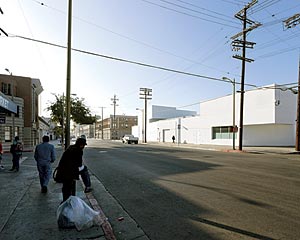One thing that often surprises first-time visitors to downtown Los Angeles is the proximity of its gleaming clutch of skyscrapers and cultural facilities to the homeless encampments in the area known as Skid Row. From the front doors of Frank Gehry’s exuberant Walt Disney Concert Hall, it takes about 15 minutes to walk—or 2 or 3 minutes to drive—the mile or so downhill to a landscape full of quiet but marked desperation, a place where social-services agencies, single-room occupancy hotels, and liquor stores serve a stubbornly large homeless population. (From the steps of City Hall or the wide plaza in front of Thom Mayne’s Caltrans headquarters, the trip is even shorter.) It is on the edge of this neighborhood that the Los Angeles architect Michael Maltzan has spent a decade and a half—or nearly his entire career as the principal of his own firm, Michael Maltzan Architecture, which he founded after leaving Gehry’s office in 1993—working on a campus of buildings for the nonprofit arts-education organization Inner-City Arts (ICA).
Maltzan is no stranger to well-heeled clients. Many miles to the west of Skid Row he is finishing work on a sizable new house for the former Hollywood power broker and art collector Michael Ovitz that is as much museum as private residence. But the ICA project, on which he has worked pro bono, is one that seems to have fully engaged him from the start. Perhaps the central reason is that the ICA’s 1-acre site, built up in three phases since 1994, has allowed Maltzan to execute a strategy that slides almost imperceptibly from architecture to urbanism and back again. The result is a family of new buildings that interacts with its context in a complex range of ways, emerging finally as a kind of protected beacon.
The buildings closest to ICA are mostly single-story warehouses selling fish, produce, or automobile parts. Clad in drab cement-block and topped by loops of razor wire, they reflect the risks inherent in doing business in a neighborhood where violent crime is rare but petty thievery is not. (When Maltzan was working with the Los Angeles firm Marmol Radziner on the project’s first phase, they regularly lost construction equipment and materials to theft.) Maltzan’s design is hardly naive about that reality: The fact that ICA brings public school students into this neighborhood—most of them by bus—means that its buildings, like the others on the block, turn a necessarily blank and security-conscious face to the city.
But this is no fortress. By the standards of Los Angeles, gated-community capital of the world, a place as full as ever of protected oases, it shows a marked curiosity about the outside world. Each of the newest buildings—which line the eastern and southern edges of the site, completing the complex as an urban object—is creased or folded back at one or more edge. Those seemingly minor architectural gestures change the whole personality of the campus’s exterior, turning what could have loomed as a series of protective walls into something more pliant—plaster into origami. They provide visual connections and bring light from outside to inside and vice versa. The pair of towers that crown the ceramics studio at the center of the campus are similarly symbolic, suggesting a desire to be seen by and look out toward the larger city.
Those efforts to make the campus appear luminous and visible are boosted by the decision to paint the whole complex white. In a neighborhood where grime is everywhere, to make a building white means signing up for a lifetime’s worth of upkeep. (White is also the color of temptation for taggers, though Maltzan says that they tend to point their spray-paint cans elsewhere out of respect for ICA’s mission.) But there is another series of messages in the choice of palette. The campus, like each group of students brought to ICA for the first time, is a blank slate, a fresh canvas, always ready for the first brushstroke. Perhaps most important of all, in a neighborhood full of people and buildings that are essentially invisible, reluctant to do much more than line up in anonymous bunches, the proudly conspicuous ICA is teaching kids to stand up and eventually stand out.



Post a comment to this article
Report Abusive Comment